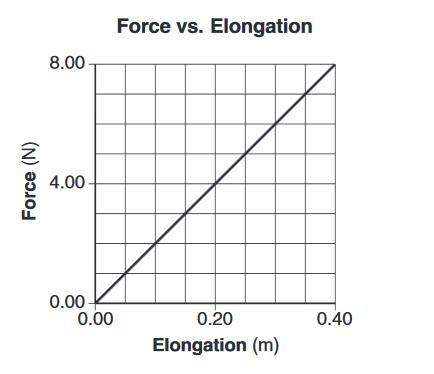
Physics, 29.01.2020 02:54 mbrisen7420
1) based on this graph of force vs. extension for a certain spring, what should be the hooke's law constant (or spring constant)?
show the full calculation using data from the figure, and report the answer in n/m.
2) suppose a 250 g mass was hung from the spring in the previous question. what would be the extension of the spring when it is in equilibrium and at rest?
write the equation needed to answer this question and the solve for the extension, recording the answer in either m or cm.
3) now the 250 g mass hanging from the spring in the previous question is pulled down an extra 10 cm and released. what would be the period and the counting frequency of the oscillations?
once again, begin with an equation and show the steps needed to find the answers.


Answers: 3


Another question on Physics

Physics, 22.06.2019 01:30
Astone is dropped with no initial velocity from the top of a cliff and hits the ground a time of 3.9 s later. what is the height of the cliff, in units of meters? you may assume that air resistance is negligible. give the answer as a positive number question 15 a figure skater is rotating at a rate of 200 revolutions per minute. what is the angular speed, in units of rad/s? 200 o 20.9 12000 o 3.33
Answers: 2

Physics, 22.06.2019 07:30
Examine the nuclear reacti why is this classified as a nuclear reaction rather than a chemical reaction? it is not balanced. a new compound is formed. a change has occurred in a nucleus. a new element has been formed.
Answers: 2

Physics, 22.06.2019 14:30
The man of mass m1 and the woman of mass m2 are standing on opposite ends of the platform of mass m0 which moves with negligible friction and is initially at rest with s = 0. the man and woman begin to approach each other. derive an expression for the displacement s of the platform when the two meet in terms of the displacement x1 of the man relative to the platform.
Answers: 1

Physics, 22.06.2019 15:00
Astudent throws a water balloon with speed v0 from a height h = 1.76 m at an angle θ = 21° above the horizontal toward a target on the ground. the target is located a horizontal distance d = 9.5 m from the student’s feet. assume that the balloon moves without air resistance. use a cartesian coordinate system with the origin at the balloon's initial position. (a) what is the position vector, rtarge t, that originates from the balloon's original position and terminates at the target? put this in terms of h and d, and represent it as a vector using i and j. (b) in terms of the variables in the problem, determine the time, t, after the launch it takes the balloon to reach the target. your answer should not include h. (c) create an expression for the balloon's vertical position as a function of time, y(t), in terms of t, vo, g, and θ. (d) determine the magnitude of the balloon's initial velocity, v0, in meters per second, by eliminating t from the previous two expressions.
Answers: 3
You know the right answer?
1) based on this graph of force vs. extension for a certain spring, what should be the hooke's law c...
Questions







English, 11.12.2019 22:31







Biology, 11.12.2019 22:31


Spanish, 11.12.2019 22:31


Mathematics, 11.12.2019 22:31

Mathematics, 11.12.2019 22:31



